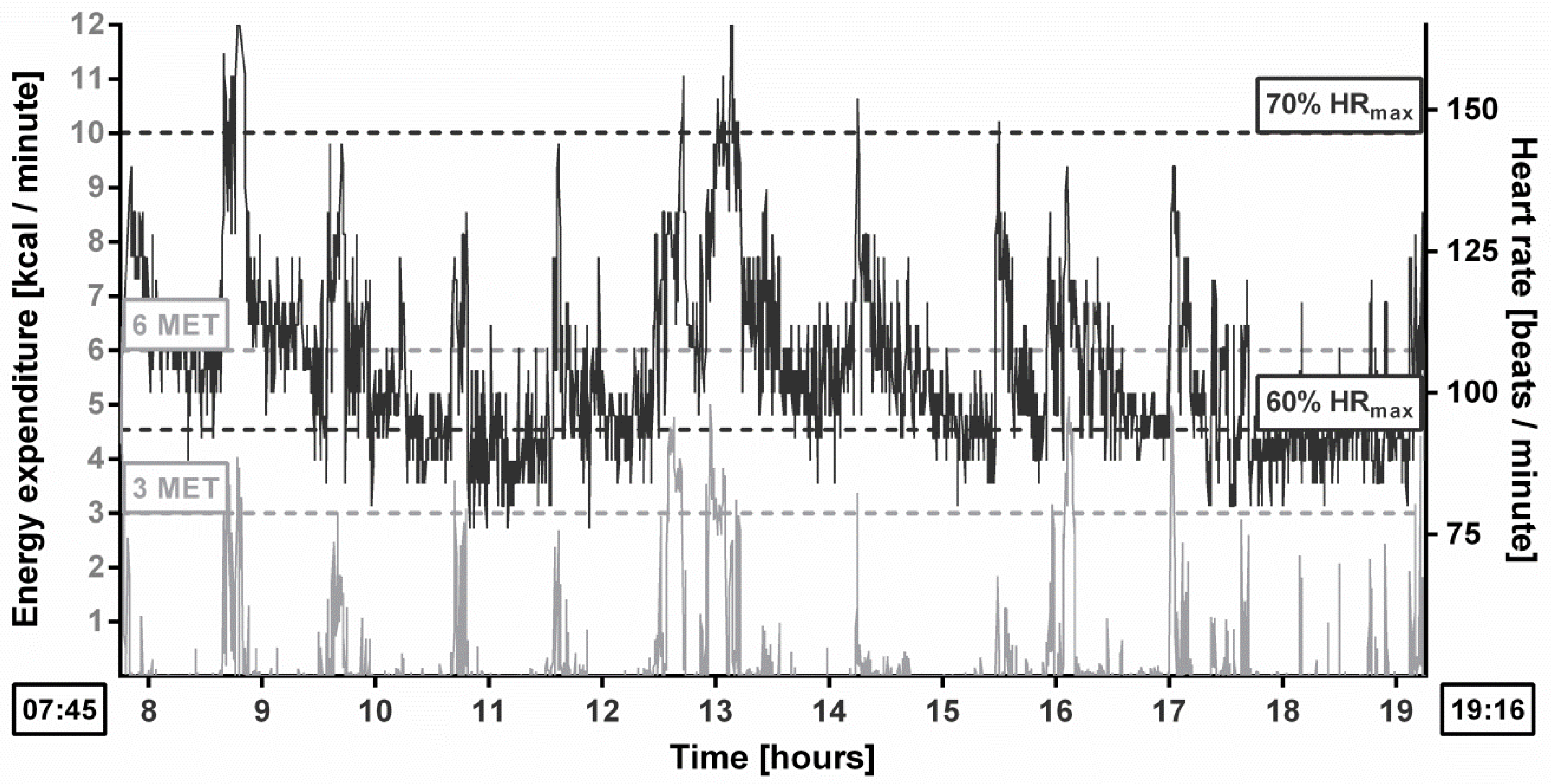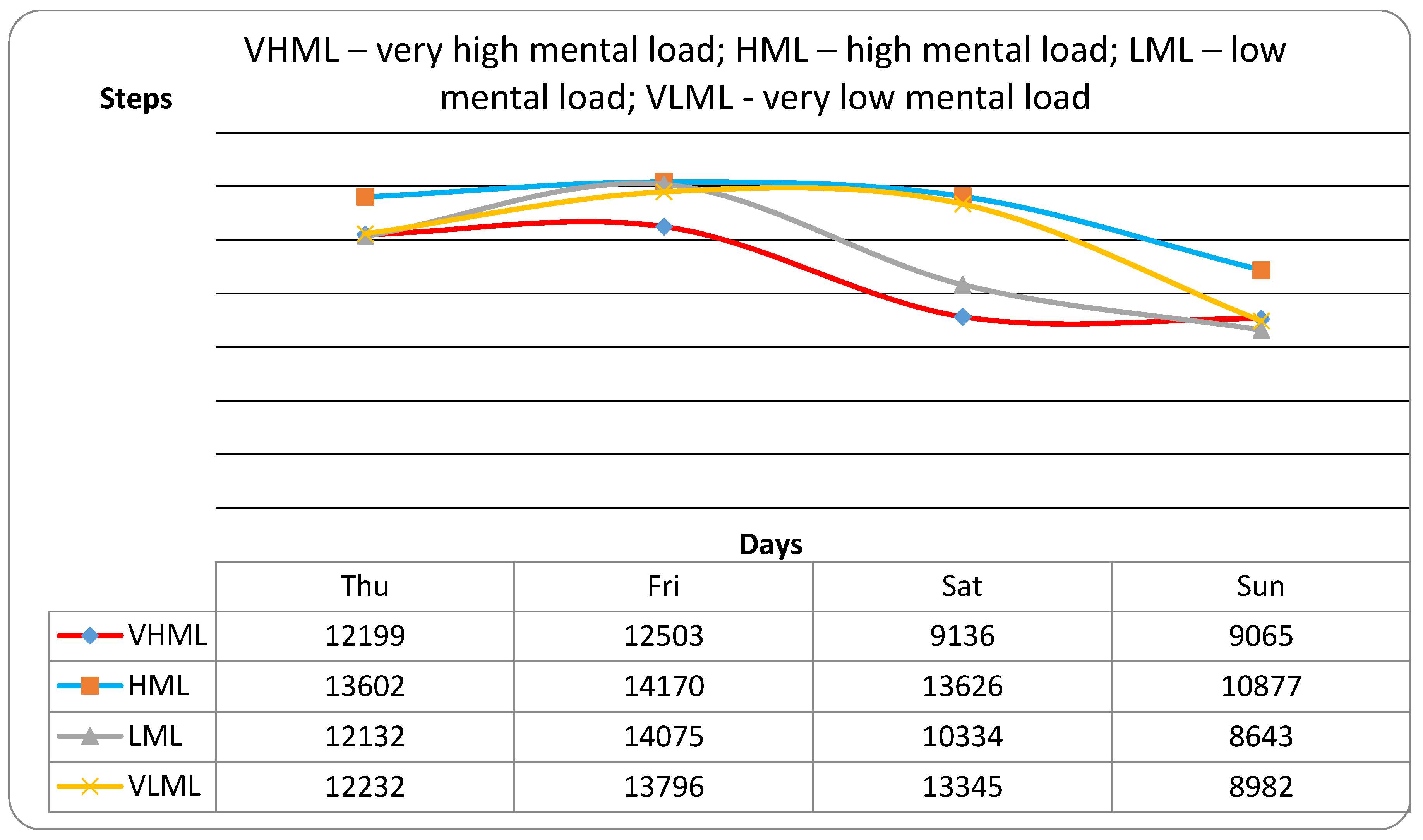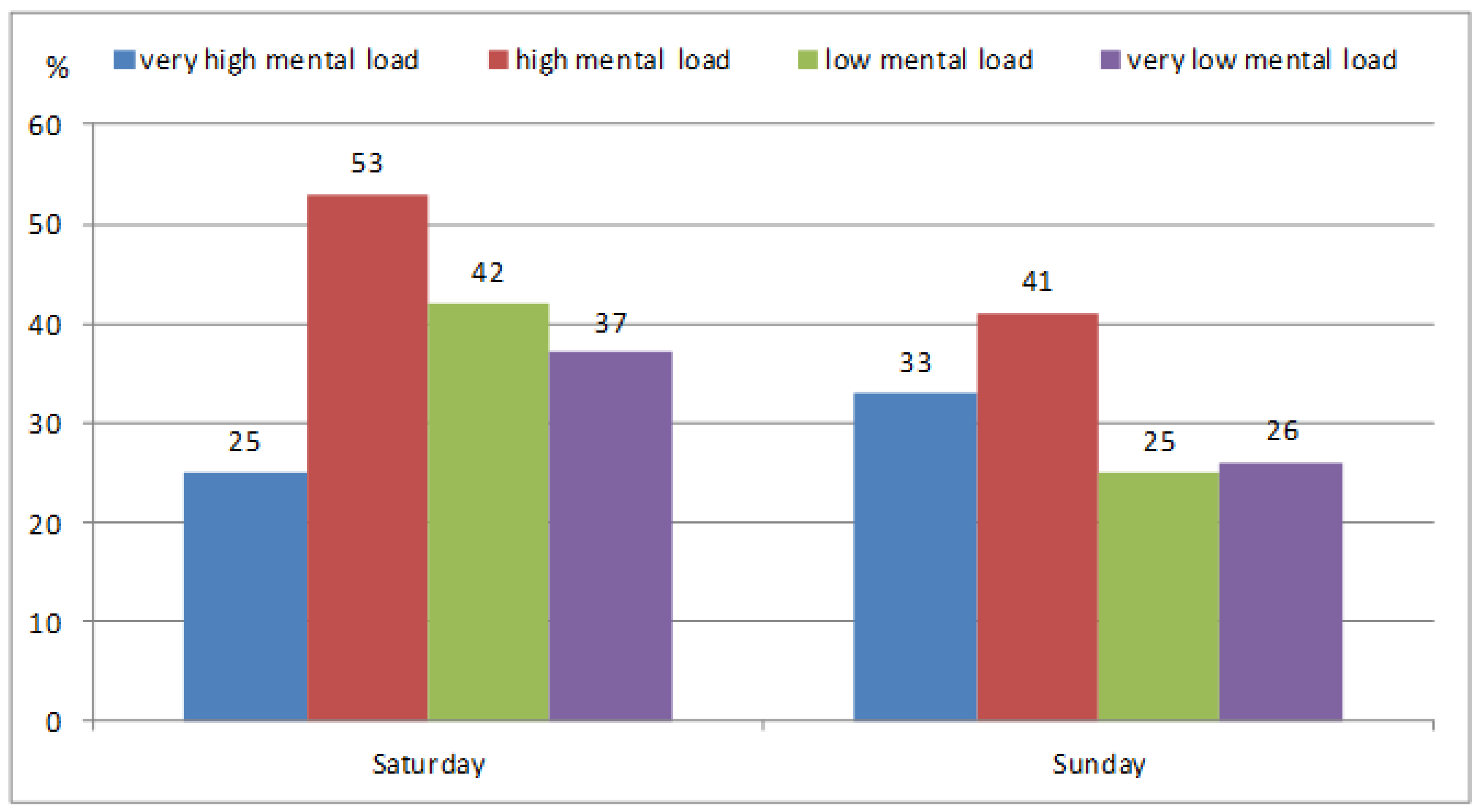Compensation for Adolescents’ School Mental Load by Physical Activity on Weekend Days
Abstract
:1. Introduction
2. Material and Methods
2.1. Research Sample and Study Design
2.2. Measurements
2.3. Data Processing
- Very high mental load (VHML)—PA < 6 METs a HR ≥ 60% HRmax
- High mental load (HML)—PA ≥ 6 METs a HR ≥ 60% HRmax
- Low mental load (LML)—PA < 6 METs a HR < 60% HRmax
- Very low mental load (VLML)—PA ≥ 6 METs a HR < 60% HRmax
2.4. Data Analysis
2.5. Ethical Principles
3. Results
3.1. The Initial Level of Physical Activity (IPAQ)
3.2. Compensation for School Mental Load on Weekend Days in Terms of PA Volume (Pedometer)
3.3. Compensation for School Mental Load on Weekend Days in Terms of PA Intensity (ActiTrainer)
4. Discussion
5. Conclusions
Acknowledgments
Author Contributions
Conflicts of Interest
References
- Salmela-Aro, K.; Tynkkynen, L. Gendered pathways in school burnout among adolescents. J. Adolesc. 2012, 35, 929–939. [Google Scholar] [CrossRef] [PubMed]
- Tavares, W.; Eva, K.W. Exploring the impact of mental workload on rater-based assessments. Adv. Health Sci. Educ. 2013, 18, 291–303. [Google Scholar] [CrossRef] [PubMed]
- Galy, E.; Cariou, M.; Mélan, C. What is the relationship between mental workload factors and cognitive load types? Int. J. Psychophysiol. 2012, 83, 269–275. [Google Scholar] [CrossRef] [PubMed]
- Shankland, R.; Genolini, Ch.; Franca, L.R.; Guelfi, J.D.; Ionescu, S. Student adjustment to higher education: The role of alternative educational pathways in coping with the demands of student life. High Educ. 2010, 59, 353–366. [Google Scholar] [CrossRef]
- Duncan, E.; Duncan, J.S.; Schofield, G. Pedometer determined physical activity and active transport in girls. Int. J. Behav. Nutr. Phys. 2008, 5, 1–9. [Google Scholar] [CrossRef] [PubMed]
- Nader, P.R.; Bradley, R.H.; Houts, R.M.; McRitchie, S.L.; O’Brien, M. Moderate-to-vigorous physical activity from ages 9 to 15 years. J. Am. Med. Assoc. (JAMA) 2008, 300, 295–305. [Google Scholar] [CrossRef] [PubMed]
- Nováková Lokvencová, P.; Frömel, K.; Chmelík, F.; Groffik, D.; Bebčáková, B. School and weekend physical activity of 15–16 year old czech, slovak and polish adolescents. Acta Gymn. 2011, 41, 39–45. [Google Scholar] [CrossRef]
- Treuth, M.S.; Catellier, D.J.; Schmitz, K.H.; Pate, R.R.; Elder, J.P.; McMurray, R.G.; Blew, R.M.; Yang, S.; Webber, L. Weekend and weekday patterns of physical activity in overweight and normal-weight adolescent girls. Obesity 2007, 15, 1782–1788. [Google Scholar] [CrossRef] [PubMed]
- Garber, C.E.; Blissmer, B.; Deschenes, M.R.; Franklin, B.A.; Lamonte, M.J.; Lee, I.-M.; Nieman, D.C.; Swain, D.P. Quantity and quality of exercise for developing and mainatining cardiorespiratory, musculoskeletal, and neuromotor fitness in apparrently healthy adults: Guidance for prescribing exercise. Med. Sci. Sports Exerc. 2011, 43, 1334–1359. [Google Scholar] [CrossRef] [PubMed]
- Abu-Omar, K.; Rutten, A.; Lehtinen, V. Mental health and physical activity in the European Union. Sozial Prav. 2004, 49, 301–309. [Google Scholar] [CrossRef]
- Dinas, P.C.; Koutedakis, Y.; Flouris, A.D. Effects of exercise and physical activity on depression. Ir. J. Med. Sci. 2011, 180, 319–325. [Google Scholar] [CrossRef] [PubMed]
- Park, S.; Cho, M.J.; Cho, S.J.; Bae, J.N.; Lee, J.; Park, J.I.; Kim, J.Y.; Lee, D.; Hong, J.P. Relationship between physical activitiy and mental health in a nationwide sample of Korean adults. Psychosomatics 2011, 52, 65–73. [Google Scholar] [CrossRef] [PubMed]
- Sieverdes, J.C.; Ray, B.M.; Sui, X.; Lee, D.C.; Hand, G.A.; Baruth, M.; Blair, S.N. Association between leisure-time physical activity and depressive symptoms in men. Med. Sci. Sports Exerc. 2011, 44, 260–265. [Google Scholar] [CrossRef] [PubMed]
- Lopez, A.D.; Mathers, C.D.; Ezzati, M.; Jamison, D.T.; Murray, C.J.L. Global and regional burden of disease and risk factors, 2001: Systematic analysis of population health data. Lancet 2006, 367, 1747–1757. [Google Scholar] [CrossRef]
- Costello, J.; Egger, H.; Angold, A. 10-year research update review: The epidemiology of child and adolescent psychiatric disorders. J. Am. Acad. Child. Adolesc. Psychiatry 2005, 44, 972–986. [Google Scholar] [CrossRef] [PubMed]
- Costelo, J.; Erkanli, A.; Angold, A. Is there an epidemic of child or adolescent depression? J. Child Psychol. Psychiatry 2006, 47, 1263–1271. [Google Scholar]
- Hoagwood, K.; Burns, B.J.; Kiser, L.; Ringeisen, H.; Schoenwald, S.K. Evidence-based practice in child and adolescent mental health services. Psychiatr. Serv. 2001, 52, 1179–1189. [Google Scholar] [CrossRef] [PubMed]
- Kaplan, S.J.; Pelcovitz, D.; Salzinger, S.; Weiner, M.; Mandel, F.S.; Lesser, M.L.; Labruna, V.E. Adolescent physical abuse: Risk for adolescent psychiatric disorders. Am. J. Psychiatry 1998, 155, 954–959. [Google Scholar] [CrossRef] [PubMed]
- Kieling, C.; Baker-Henningham, H.; Belfer, M.; Conti, G.; Ertem, I.; Omigbodun, O.; Rohde, L.A.; Srinath, S.; Ulkuer, N.; Rahman, A. Child and adolescent mental health worlwide: Evidence for action. Lancet 2011, 378, 1515–1525. [Google Scholar] [CrossRef]
- Sirard, J.R.; Bruening, M.; Wall, M.M.; Eisenberg, M.E.; Kim, S.K.; Neumark-Sztainer, D. Physical activity and screen time in adolescents and their friends. Am. J. Prev. Med. 2013, 44, 48–55. [Google Scholar] [CrossRef] [PubMed]
- Ramirez, E.R.; Norman, G.J.; Rosenberg, D.E.; Jacqueline, K.; Saelens, B.E.; Durant, N.; Sallis, J.F. Adolescents screen time and rules to limit screen time in the home. J. Adolesc. Health 2011, 48, 379–385. [Google Scholar] [CrossRef] [PubMed]
- Hamer, M.; Stamatakis, E.; Mishra, G.D. Television- and screen-based activity and mental well-being in adults. Am. J. Prev. Med. 2010, 38, 375–380. [Google Scholar] [CrossRef] [PubMed]
- Scott, D.; Happell, B. The high prevalence of poor physical health and unhealthy lifestyle behaviours in individuals with severe mental illness. Issues Ment. Health Nurs. 2011, 32, 589–597. [Google Scholar] [CrossRef] [PubMed]
- Robinson, M.; Kendall, G.E.; Jacoby, P.; Hands, B.; Beilin, L.J.; Silburn, S.R.; Zubrick, S.R.; Oddy, W.H. Lifestyle and demographic correlates of poor mental health in early adolescence. J. Paediatr. Child Health 2011, 47, 54–61. [Google Scholar] [CrossRef] [PubMed]
- Chaudhuri, A.; Behan, P.O. Fatigue and basal ganglia. J. Neurol. Sci. 2000, 179, 34–42. [Google Scholar] [CrossRef]
- Singh, S.; Aghazadeh, F.; Ray, T.G. Interaction of physical and mental work. Int. J. Occup. Saf. Ergon. 2002, 8, 451–463. [Google Scholar] [CrossRef] [PubMed]
- Hamer, M.; Endrighi, R.; Poole, L. Physical activity, stress reduction, and mood: Insight into immunological mechanisms. Psychoneuroimmunology 2012, 934, 89–102. [Google Scholar]
- Huan, C.J.; Webb, H.E.; Zourdos, M.C.; Acevedo, E.O. Cardiovacular reactivity, stress, and physical activity. Front. Physiol. 2013, 4, 1–13. [Google Scholar]
- Kouvonen, A.; Vahtera, J.; Oksanen, T.; Pentti, J.; Väänänen, A.K.P.; Heponiemi, T.; Salo, P.; Virtanen, M.; Kivimäki, M. Chronic workplace stress and insufficinet physical activity: A cohort study. Occup. Environ. Med. 2013, 70, 3–8. [Google Scholar] [CrossRef] [PubMed]
- Martikainen, S.; Pesonen, A.K.; Lahti, J.; Heinonen, K.; Feldt, K.; Pyhälä, R.; Tammelin, T.; Kajantie, E.; Eriksson, J.G.; Strandberg, T.E.; et al. Higher levels of physical activity are associated with lower hypothalamic-pituitary-adrenocortical axis reactivity to psychosocial stress in children. J. Clin. Endocrinol. Metab. 2013, 98, 619–627. [Google Scholar]
- Centers for Disease Control and Prevention. Youth Violence: Risk and Protective Factors. Available online: http://www.cdc.gov/violenceprevention/youthviolence/riskprotectivefactors.html#Risk Factors (accessed on 15 September 2015).
- Davis, C.L.; Tomporowski, P.D.; McDowell, J.E.; Austin, B.P.; Miller, P.H.; Yanasak, N.E.; Allison, J.D.; Naglieri, J.A. Exercise improves executive function and achievement and alters brain activation in overwieght children: A randomized, controlled trial. Health Psychol. 2011, 30, 91–98. [Google Scholar] [CrossRef] [PubMed]
- Davis, C.L.; Tomporowski, P.D.; Boyle, C.A.; Waller, J.L.; Miller, P.H.; Naglieri, J.A. Effects of aerobic exercise on overweight children’s cognitive functioning. Res. Q. Exerc. Sport 2007, 78, 510–519. [Google Scholar] [CrossRef] [PubMed]
- Carek, P.J.; Laibstain, S.E.; Carek, S.M. Exercise for the treatment of depression and anxiety. Int. J. Psychiatry Med. 2011, 41, 15–28. [Google Scholar] [CrossRef] [PubMed]
- Haskell, W.L.; Lee, I.M.; Pater, R.R.; Powell, K.E.; Blair, S.N.; Franklin, B.A.; Macera, C.A.; Heath, G.W.; Thompson, P.D.; Bauman, A. Physical activity and public health: Updated recommendation for adults from the American College of Sports Medicine and the American heart Association. Med. Sci. Sports Exerc. 2007, 39, 1423–1434. [Google Scholar] [CrossRef] [PubMed]
- Ekelund, U.; Poortvliet, E.; Yngve, A.; Hurtig-Wennlöv, A.; Nilsson, A.; Sjöström, M. Heart rate as an indicator of intensity of physical activity in human adolescents. Eur. J. Appl. Physiol. 2001, 85, 224–249. [Google Scholar] [CrossRef]
- Dyrstad, M.S.; Hausken, K. Comparing accelerometer and heart rate monitor in interval running, interval spinning and Zumba. Int. J. Appl. Sport. Sci. 2014, 26, 89–98. [Google Scholar]
- Brage, S.; Brage, N.; Franks, P.W.; Ekelund, U.; Wong, M.Y.; Andersen, L.B.; Froberg, K.; Wareham, N.J. Branched equation modeling of simultaneous accelerometry and heart rate monitoring improves estimate of directly measured physical activity energy expenditure. J. Appl. Physiol. 2004, 96, 343–351. [Google Scholar] [CrossRef] [PubMed]
- Butte, N.F.; Ekelund, U.; Westerterp, K.R. Assessing physical activity using wearable monitors: Measures of physical activity. Med. Sci. Sport Exerc. 2012, 44, S5–S12. [Google Scholar] [CrossRef] [PubMed]
- Luque-Casado, A.; Zabala, M.; Morales, E.; Mateo-March, M.; Sanabria, D. Cognitive performance and heart rate variability: The influence of fitness level. PLoS ONE 2013, 8, e56935. [Google Scholar]
- Luft, C.B.; Takase, E.; Darby, D. Heart rate variability and cognitive function: Effects of physical effort. Biol. Psychol. 2009, 82, 186–191. [Google Scholar] [CrossRef] [PubMed]
- Hjortskov, N.; Rissén, D.; Blangsted, A.K.; Fallentin, N.; Lundberg, U.; Søgaard, K. The effect of mental stress on heart rate variability and blood pressure during computer work. Eur. J. Appl. Physiol. 2004, 92, 84–89. [Google Scholar] [CrossRef] [PubMed]
- Křen, F.; Chmelík, F.; Frömel, K.; Fical, P.; Kudláček, M. Questionnaires PPA and IPAQ for Indares.com. Available online: http://www.isvav.cz/resultDetail.do?rowId=RIV%2F61989592%3A15510%2F08%3A00006265!RIV10-MSM-15510___ (accessed on 7 January 2016).
- Cohen, J. Statistical Power Analysis for the Behavioral Sciences, 2 ed.; Lawrence Erlbaum Associates: New York, NY, USA, 1988. [Google Scholar]
- Fan, X. Statistical significance and effect size in education research: Two sides of a coin. J. Educ. Res. 2001, 94, 275–282. [Google Scholar] [CrossRef]
- Svozil, Z.; Fromel, K.; Chmelik, F.; Jakubec, L.; Groffik, D.; Safar, M. Mental load and its compensation by physical activity in adolescents at secondary schools. Cent. Eur. J. Public Health 2015, 23, 44–49. [Google Scholar]
- Block, R.A.; Hancock, P.A.; Zakay, D. How cognitive load affects duration judgments: A meta-analytic review. Acta Psychol. 2010, 134, 330–343. [Google Scholar] [CrossRef] [PubMed]
- Ryan, A.M.; Patrick, H. The classroom social environment and changes in adolescents’ motivation and engagement during middle school. Am. Educ. Res. J. 2001, 38, 437–460. [Google Scholar] [CrossRef]
- Treasure, D.C.; Roberts, G.C. Cognitive and affective concomitants of task and ego goal orientations during the middle school years. J. Sport Exerc. Psychol. 1994, 6, 15–28. [Google Scholar]
- Wang, M.T.; Holcombe, R. Adolescents’ perceptions of school environement, engagement, and academic achievement in middle school. Am. Educ. Res. J. 2010, 47, 633–662. [Google Scholar] [CrossRef]
- Fairclough, S.J.; Beighle, A.; Erwin, H.; Ridgers, N.D. School day segmented physical activity patterns of high and low active children. BMC Public Health 2012, 12, 406–418. [Google Scholar] [CrossRef] [PubMed]
- Brusseau, T.A.; Kulinna, P.H.; Tudor-Locke, C.; van der Mars, H.; Darst, P.W. Pedometer determined segmented physical activity patterns of fourth and fifth grade children. J. Phys. Act. Health 2011, 8, 279–286. [Google Scholar] [PubMed]
- Tudor-Locke, C.; Lee, S.M.; Morgan, C.F.; Beighle, A.; Pangrazi, R.P. Children’s pedometer-determined phyiscal activity during the segmented school day. Med. Sci. Sports Exerc. 2006, 38, 1732–1738. [Google Scholar] [CrossRef] [PubMed]
- Fairclough, S.J.; Butcher, Z.H.; Stratton, G. Whole-day and segmented-day physical activity variability of northwest England school children. Prev. Med. 2007, 4, 421–425. [Google Scholar] [CrossRef] [PubMed]
- Steele, R.M.; van Sluijs, E.M.; Sharp, S.J.; Landsbaugh, J.R.; Ekelund, U.; Griffin, S.J. An investigation of patterns of children’s sedentary and vigorous physical activity throughout the week. Int. J. Behav. Nutr. Phys. 2010, 7, 88. [Google Scholar] [CrossRef] [PubMed]
- Ridgers, N.D.; Timperio, A.; Cerin, E.; Salmon, J. Compensation of physical activity and sedentary time in primary school children. Med. Sci. Sports Exerc. 2014, 46, 1564–1569. [Google Scholar] [CrossRef] [PubMed]
- Wilkin, T.J. Can we modulate physical activity in children? Int. J. Obes. 2011, 35, 392–399. [Google Scholar] [CrossRef] [PubMed]
- Long, M.W.; Sobol, A.M.; Cradock, A.L.; Subramanian, S.V.; Blendon, R.J.; Gortmaker, S.L. School-day and overall physical activity among youth. Am. J. Prev. Med. 2013, 42, 150–157. [Google Scholar] [CrossRef] [PubMed]
- Rowlands, A.V.; Pilgrim, E.L.; Eston, R.G. Patterns of habitual activitz across weekdazs and weekend dazs in 9–11-zear-old children. Prev. Med. 2008, 46, 317–324. [Google Scholar] [CrossRef] [PubMed]
- Fairclough, S.J.; Ridgers, N.D.; Welk, G. Correlates of children’s modetarte and vigorous physical activity during weekdays and weekends. J. Phys. Act. Health 2012, 9, 129–137. [Google Scholar] [PubMed]
- Verloinge, M.; van Lippevelde, W.; Maes, L.; Yildirim, M.; Chinapaw, M.; Manios, Y.; Androutsos, O.; Kovács, É.; Bringolf-Isler, B.; Brug, J.; et al. Levels of phyiscal activity and sedentary time among 10- to 12-year-old boys and girls across 5 European countries using accelerometers: An observational study within the ENERGY-project. Int. J. Behav. Nutr. Phys. 2012, 9, 34–41. [Google Scholar]
- Marshall, S.J.; Levy, S.S.; Tudor-Locke, C.E.; Kolkhorst, F.W.; Wooten, K.M.; Ji, M.; Macera, C.A.; Ainsworth, B.E. Translating physical activity recommendations into a pedometer-based step boal: 3000 steps in 30 min. Am. J. Prev. Med. 2009, 36, 410–415. [Google Scholar] [CrossRef] [PubMed]
- Tudor-Locke, C.; Craig, C.L.; Brown, W.J.; Clemes, S.A.; De Cocker, K.; Giles-Corti, B.; Hatano, Y.; Inoue, S.; Matsudo, S.M.; Mutrie, N.; et al. How many steps/day are enough? For adults. Int. J. Behav. Nutr. Phys. 2011, 8, 79–95. [Google Scholar] [CrossRef] [PubMed]
- Metcalf, B.S.; Hosking, J.; Jeffery, A.N.; Heley, W.E.; Wilkin, T.J. Exploring the adolescent fall in physical activity: A 10-yr cohort study. Med. Sci. Sports Exerc. 2015, 47, 2084–2092. [Google Scholar] [CrossRef] [PubMed]
- Ortega, F.B.; Konstabel, K.; Pasquali, E.; Ruiz, J.R.; Hurtig-Wennlöf, A.; Mäestu, J.; Löf, M.; Harro, J.; Bellocco, R.; Labayen, I.; et al. Objectively measured phyiscal activity and sedentary time during childhood, adolescence and young adulthood: A cohort study. PLoS ONE 2013, 8, e60871. [Google Scholar] [CrossRef] [PubMed]
- Hallal, P.C.; Andersen, L.B.; Bull, F.C.; Guthold, R.; Haskell, W.; Ekelund, U. Global physical activity levels: Surveillance progress, pitfalls, and prospects. Lancet 2012, 380, 247–257. [Google Scholar] [CrossRef]
- Gordon-Larsen, P.; Nelson, M.C.; Popkin, B.M. Longitudinal physical activity and sedentary behavior trends: Adolescence to adulthood. Am. J. Prev. Med. 2004, 27, 277–283. [Google Scholar] [CrossRef] [PubMed]
- Eston, R.G.; Rowlands, A.V.; Ingledew, D.K. Validity of heart rate, pedometry, and accelerometry for predicting the energy cost of children’s activities. J. Appl. Physiol. 1998, 84, 362–371. [Google Scholar] [PubMed]



| Characteristics | VHML (n = 40) | HML (n = 34) | LML (n = 96) | VLML (n = 57) | H | p | η2 |
|---|---|---|---|---|---|---|---|
| Mdn/IQR | Mdn/IQR | Mdn/IQR | Mdn/IQR | ||||
| MET—min/week | 3026/5755 | 4070/8283 | 4180/6665 | 3833/3045 | 4.90 | 0.179 | 0.022 * |
| Sitting—School Days | 470/240 | 420/120 | 480/213 | 420/130 | 3.23 | 0.357 | 0.014 * |
| Sitting—Weekend | 315/278 | 293/180 | 240/240 | 300/300 | 3.59 | 0.309 | 0.016 * |
| Characteristics of PA | VHML (n = 40) | HML (n = 34) | LML (n = 96) | VLML (n = 57) | H | p | η2 | ||||
|---|---|---|---|---|---|---|---|---|---|---|---|
| Mdn | IQR | Mdn | IQR | Mdn | IQR | Mdn | IQR | ||||
| kcal·kg−1·h−1 | 1.49 | 1.15 | 2.32 | 1.72 | 2.07 | 2.05 | 2.01 | 1.84 | 7.22 | 0.065 | 0.032 |
| steps·h−1 (number) | 427 | 353 | 729 | 539 | 576 | 437 | 505 | 328 | 8.41 a | 0.038 | 0.037 |
| physical inactivity (min·h−1) | 40.42 | 10.43 | 35.77 | 10.97 | 38.03 | 10.27 | 39.17 | 11.61 | 4.84 | 0.184 | 0.021 |
| ≥3 METs (min·h−1) | 1.21 | 1.84 | 3.48 | 3.62 | 2.13 | 2.71 | 2.08 | 3.13 | 9.66 a | 0.022 | 0.043 |
| ≥60 HRmax (min·h−1) | 2.11 | 5.44 | 1.87 | 8.40 | 1.72 | 4.55 | 1.12 | 4.75 | 4.81 | 0.187 | 0.021 |
© 2016 by the authors; licensee MDPI, Basel, Switzerland. This article is an open access article distributed under the terms and conditions of the Creative Commons by Attribution (CC-BY) license (http://creativecommons.org/licenses/by/4.0/).
Share and Cite
Kudláček, M.; Frömel, K.; Jakubec, L.; Groffik, D. Compensation for Adolescents’ School Mental Load by Physical Activity on Weekend Days. Int. J. Environ. Res. Public Health 2016, 13, 308. https://doi.org/10.3390/ijerph13030308
Kudláček M, Frömel K, Jakubec L, Groffik D. Compensation for Adolescents’ School Mental Load by Physical Activity on Weekend Days. International Journal of Environmental Research and Public Health. 2016; 13(3):308. https://doi.org/10.3390/ijerph13030308
Chicago/Turabian StyleKudláček, Michal, Karel Frömel, Lukáš Jakubec, and Dorota Groffik. 2016. "Compensation for Adolescents’ School Mental Load by Physical Activity on Weekend Days" International Journal of Environmental Research and Public Health 13, no. 3: 308. https://doi.org/10.3390/ijerph13030308
APA StyleKudláček, M., Frömel, K., Jakubec, L., & Groffik, D. (2016). Compensation for Adolescents’ School Mental Load by Physical Activity on Weekend Days. International Journal of Environmental Research and Public Health, 13(3), 308. https://doi.org/10.3390/ijerph13030308






